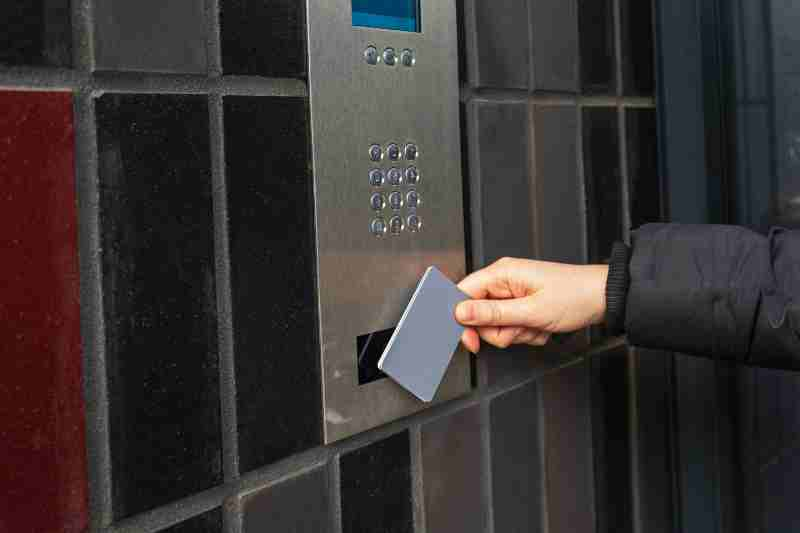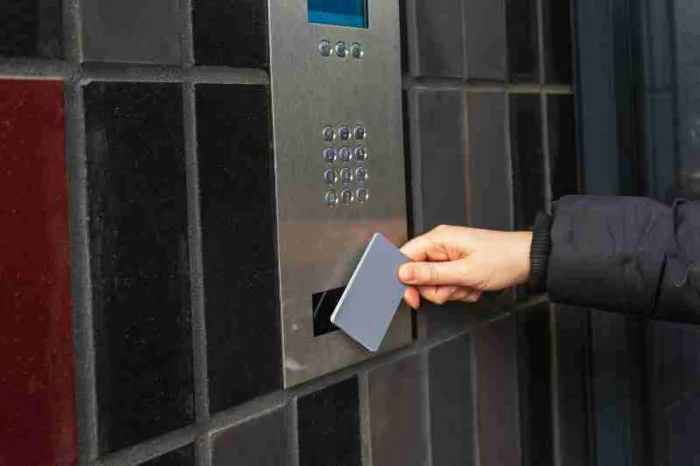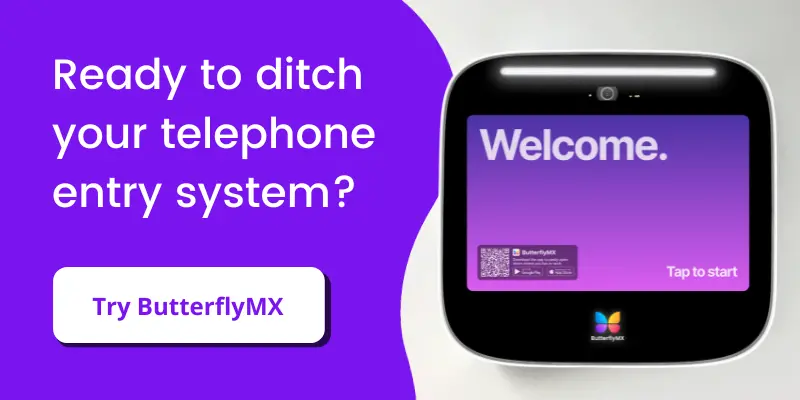Key Takeaways
- A wireless telephone entry system is an electronic device that enables communication and building access between visitors and residents.
- Wireless phone entry systems connect calls from the door to the resident via a cellular network or WiFi.
- Although wireless telephone entry systems are a significant improvement, they still have limits, such as storage issues and a lack of modernity.
- The best alternative to a wireless telephone entry system is a video intercom system.

Telephone entry systems are among the oldest types of visitor management systems. However, wireless telephone entry systems have only recently become available in multifamily and commercial properties.
As technology progresses, so does our approach to building security. In this post, we discuss the best wireless entry systems, how they work, and how to choose the right one for you.
This post will cover:
- 3 best wireless telephone entry systems
- What is a wireless telephone entry system?
- How do wireless telephone entry systems work?
- What are the disadvantages of a telephone entry system?
- What is the alternative to a telephone entry system?
Watch how ButterflyMX works:
3 best wireless telephone entry systems
Below, we’ve compiled a list of the best telephone entry and intercom systems for helping secure your property.
Three top wireless telephone entry systems and intercoms include:
1. Doorking
First, the Doorking telephone entry model has a traditional, simple design with few features or bells and whistles.
However, they aren’t complicated models and fit the needs of simple day-to-day operations.
Features of Doorking systems vary by model but may include:
- LED directory panel
- Ability to store thousands of names and phone numbers
- Programmable via PC
- Tamper alert switch
- Weather sealing
2. Linear
Next, Linear offers a catalog of different products, including door openers, access controls, and more. Moreover, Linear telephone entry systems can be programmed locally using the keypad. But, unlike ButterflyMX, remote management and monitoring will vary by model.
Features of Linear tele entry systems include:
- Built-in keypads.
- Electronic tenant directory.
- The most basic model allows up to 125 tenants.
- An add-on camera, metal trim rings, and pedestal mounts can be added.
3. Mircom
Lastly, Mircom is designed for multifamily buildings like apartments, condos, and gated communities. Furthermore, Mircom phone entry systems are basic property entry solutions.
While the basic models are more affordable, you can find video intercom features with certain models.
Mircom system features:
- Option to add key card access and elevator controls.
- Hands-free electronic directory models.
- Video telephone access system.
- Electronic or paper directory, depending on the model.
- Programmable via the built-in keypad or with a computer.
What is a wireless telephone entry system?
A wireless telephone entry system is an electronic device that enables communication and building access between visitors and residents. Initially, telephone entry systems only worked via landline connections and required physical hardwiring.
However, as cell phones became readily available, telephone entry manufacturers started incorporating the same wireless technology into their systems.
Unlike traditional telephone door entry systems, wireless systems do not require a physical landline to power the device. Instead, they rely on a cellular signal. This makes the installation simpler and eliminates the expense of installing a dedicated telephone line in your building.
Lastly, it’s important to note that the system must be connected to a cellular control box, which comes at an added expense. Your building must pay for a cellular service plan to enable calls from the entry system.
How do wireless telephone entry systems work?
Wireless phone entry systems connect calls from the door to the resident via a cellular network or WiFi.
Wireless entry systems have two main components:
- The base station. The device installed outdoors at the entrance. Visitors use it to search a directory and call the resident they’re visiting.
- The substations. Once the base station is connected to a cellular network or WiFi, the tenant can use their phones to answer visitors’ calls and grant them access to the property. Then, residents press ‘9’ on their phones to open the door or gate.
The two most common ways to connect to a cellular telephone entry system:
Cellular network
Wireless telephone entry systems operating over a cellular network require installing a cellular control box.
Like your cell phone, a cellular control box is a fee to use the cellular service. Further, every cellular control box operates on a different cellular network (i.e., AT&T or Verizon), so prices fluctuate based on the provider.
WiFi connection
A much easier way to enable telephone entry systems to be wireless is to connect them to your building’s WiFi. However, with older systems, you may need to wire the device to the internet using an Ethernet cable. Some cellular telephone entry systems also offer Power over Ethernet (PoE) technology, which allows an Ethernet cable to serve as both a power supply and an internet connection.
When connected to the same WiFi network, residents’ smartphones signal the entry system to release the door latch, allowing entry into the building. In most cases for a telephone entry system, residents must download a mobile app to use their phones as a door or gate opener with the WiFi telephone entry system.
What are the disadvantages of a telephone entry system?
Although wireless telephone entry systems are a significant improvement, they still have limits, such as storage issues and a lack of modernity.
The three main limitations of telephone entry systems are:
- They aren’t cloud-based. Wireless telephone entry systems aren’t cloud-based, so property staff can’t manage the system or update the tenant directory remotely from any device. At best, staff must download software to update the system from a single computer. Additionally, these entry systems can’t integrate with your existing property management software or smart home devices.
- They don’t have video capabilities. Telephone entry systems don’t have enough bandwidth for video calls. Of the few with cameras, the wired/wireless connection isn’t robust enough to transfer big video files. So, residents can’t see or identify visitors before granting them access.
- Only offer one method of access. Telephone entry systems offer only one way of granting property access: a phone call. Further, unlike Internet Protocol (IP) intercom systems, residents can’t open doors or gates using multiple methods.
What is the alternative to telephone entry systems?
The best alternative to a wireless telephone entry system is a video intercom system.
While traditional telephone entry systems can improve front entrance surveillance, they offer little in the way of convenience and robust security. As such, you’re better off with a video intercom that enhances security and convenience for residents and property staff.
Moreover, if you’re looking for a modern, next-generation take on the wireless telephone entry system, then ButterflyMX is for you.
Features of the ButterflyMX video intercom system include:
- In-device RFID (Radio Frequency Identification) that supports key fobs and cards.
- 156º wide-angle camera for a full-range view.
- Wireless connectivity.
- In-hardware 5GHz WiFi.
- A top-rated mobile app with swipe-to-open button.
- A bright LED screen in 8” and 12” models that’s easy to view.
- Vandal-resistant and weatherproof.
The ButterflyMX video intercom system was created with your security and convenience needs in mind. Now, with a top-rated smartphone app, you can upgrade your tenants’ living experiences and enhance your day-to-day operations.







